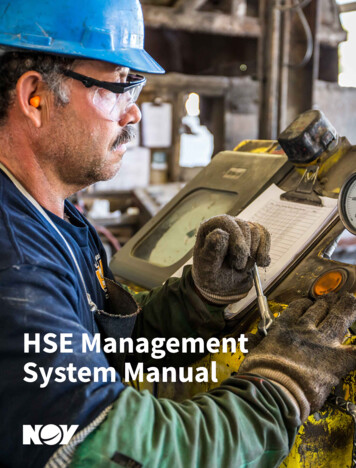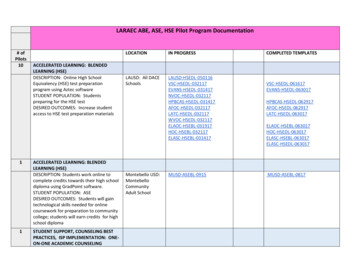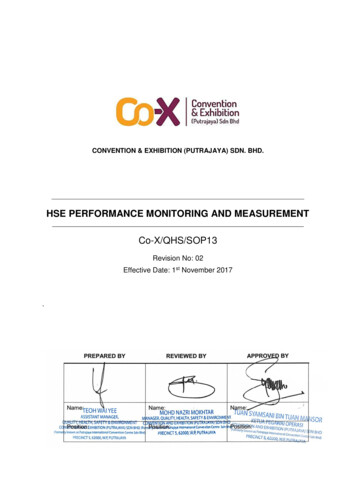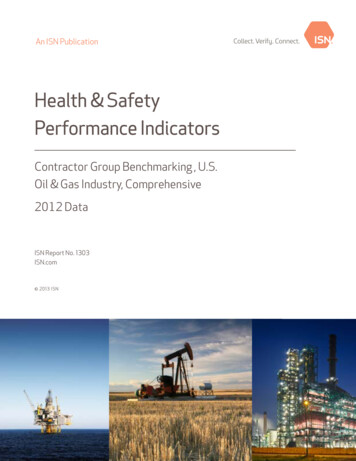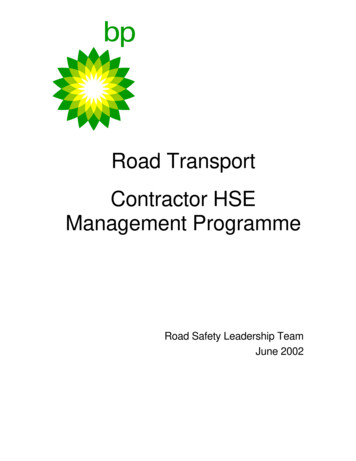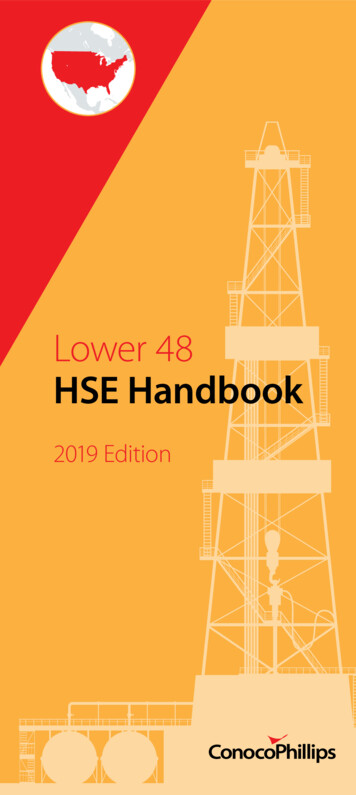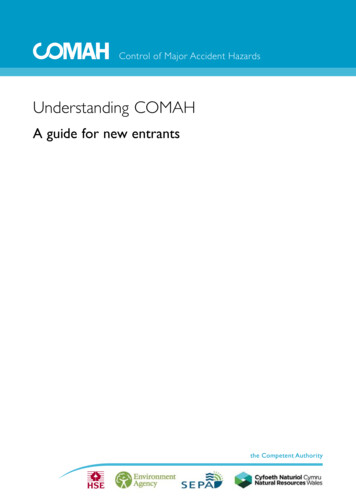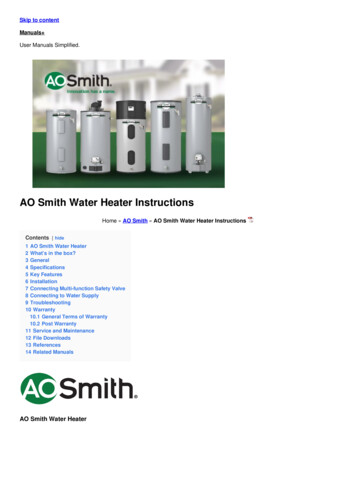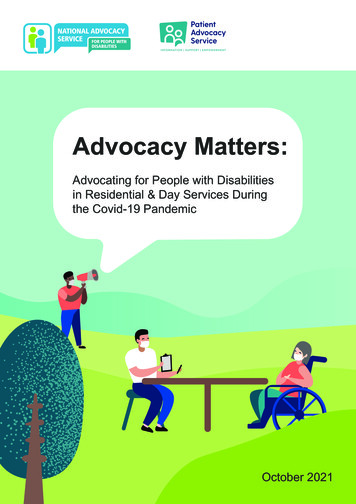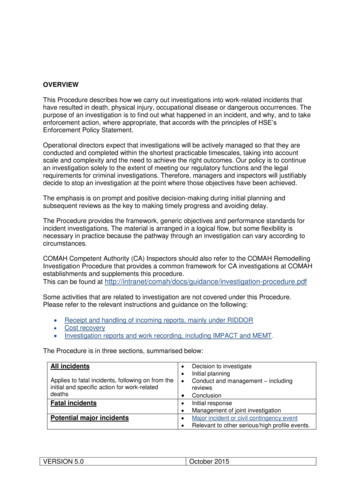
Transcription
OVERVIEWThis Procedure describes how we carry out investigations into work-related incidents thathave resulted in death, physical injury, occupational disease or dangerous occurrences. Thepurpose of an investigation is to find out what happened in an incident, and why, and to takeenforcement action, where appropriate, that accords with the principles of HSE’sEnforcement Policy Statement.Operational directors expect that investigations will be actively managed so that they areconducted and completed within the shortest practicable timescales, taking into accountscale and complexity and the need to achieve the right outcomes. Our policy is to continuean investigation solely to the extent of meeting our regulatory functions and the legalrequirements for criminal investigations. Therefore, managers and inspectors will justifiablydecide to stop an investigation at the point where those objectives have been achieved.The emphasis is on prompt and positive decision-making during initial planning andsubsequent reviews as the key to making timely progress and avoiding delay.The Procedure provides the framework, generic objectives and performance standards forincident investigations. The material is arranged in a logical flow, but some flexibility isnecessary in practice because the pathway through an investigation can vary according tocircumstances.COMAH Competent Authority (CA) Inspectors should also refer to the COMAH RemodellingInvestigation Procedure that provides a common framework for CA investigations at COMAHestablishments and supplements this procedure.This can be found at procedure.pdfSome activities that are related to investigation are not covered under this Procedure.Please refer to the relevant instructions and guidance on the following: Receipt and handling of incoming reports, mainly under RIDDORCost recoveryInvestigation reports and work recording, including IMPACT and MEMT.The Procedure is in three sections, summarised below:All incidentsApplies to fatal incidents, following on from theinitial and specific action for work-relateddeathsFatal incidentsPotential major incidentsVERSION 5.0 Decision to investigateInitial planningConduct and management – includingreviewsConclusionInitial responseManagement of joint investigationMajor incident or civil contingency eventRelevant to other serious/high profile events.October 2015
The content of each section is arranged under:Headlines Summary of the section’s scope and contentResponsibilities and actions The headlines expanded into “who” and “what”(with flexibility between roles to maintain pace)Performance standards andcriteria Our policies in terms of quality, criteria, timescales andfactors to take into accountVERSION 5.0October 2015
ALL INCIDENTSThis section covers: decisions whether to investigate reported incidents (except where already actionedfor fatal and major incidents) initial planning conducting and managing, including reviews concluding investigations, including when to curtail.DECISION WHETHER TO INVESTIGATEHEADLINESApply the Incident Selection Criteria (ISC) to decision-makingIdentify incidents mandatory for investigationArrange for initial enquiries to be made where necessaryRe-direct incidents that are not within HSE’s enforcement responsibilityJustify decisions not to investigate incidents that meet the ISC with reasonsRe-allocate investigations where local workload pressures would lead to delayRESPONSIBILITIES & ACTIONSBand 2 Band 1VERSION 5.0 Select incidents that meet the ISC as mandatory for investigation wherethere is enough available information to decide without further enquiryRe-direct any incidents that are not for HSE in accordance with therelevant Memorandum of Understanding, Protocol or other guidanceArrange for initial enquiries* into incidents that fit the Criteria: Initialenquiries in order to reach a decision whether investigation is mandatory(* by administrative support team, VO/RCO or inspector as appropriate)Decide whether any incidents meeting the ISC should not beinvestigatedRecord a decision not to investigate directly on COIN, selecting one ofthe reasons given in the Criteria: Factors weighing against investigationInform the Band 1 if the team does not have the capacity to take on anincident that should be investigated.Re-allocate investigations across teams, Units and Divisions whenresourcing issues arise.October 2015
CRITERIA FOR DECISION-MAKINGInitialenquiriesEnquiries should be made when there is not enough information to decidewhether: one of the factors weighing against a decision to pursue an investigationmight apply, even though the incident meets the ISCa serious incident to a non-employee falls within HSE’s priorities forenforcement on Section 3.Enquiries should not continue beyond the point when the Band 2 has enoughinformation to decide whether to investigate or not.FactorsweighingagainstinvestigationThe grounds for not investigating incidents that meet the selection criteriaare where: it is impractical to do so, for example where key witnesses or otherevidence is unavailableit is clear that all reasonably practicable precautions were in place at thetime of the incident to reduce the risk of it occurringPERFORMANCE STANDARDTimescalesfor selectiondecisionsThe decision whether to investigate should be made within 5 working daysfrom when the Band 2 receives notification, or as soon as the informationessential to making a decision becomes available.INITIAL PLANNINGHEADLINESAssess the incident and resource the investigationGather relevant information about the dutyholder(s) where their identity is knownSet initial objectives and identify any fast-track actionsConsider any necessary support required from specialists or the Sector at the outsetInvolve and communicate with other enforcement agencies where appropriateIdentify any foreseeable health and safety issues and site conditions that may affect theinvestigatorsProduce a fit-for-purpose planRESPONSIBILITIES & ACTIONSVERSION 5.0October 2015
Band 2 LeadinspectorTake account of the following factors when allocating resources to theinvestigation:o its likely scale and complexityo the type and volume of material to be collected while fresh andavailableo the urgency for first attendance at the siteo the most appropriate mix of inspector and VO/RCO deploymentEnsure that the lead inspector’s initial objectives and actions areappropriate and geared to making timely and effective progressSet the timing of the first review.Consider, in liaison with the B2, how best to deploy staff resources toachieve the following actions, delegating to other team members - VO/RCO,B3 or B4 colleagues - where appropriate: Arrange for information held about the dutyholder(s) to be suppliedConsider the running order for collecting the early material that is likely tobe most productive and efficientAssess whether any relevant material is at risk of being lost, destroyedor disturbed, and needs to be secured without delay to avoid detriment tothe investigationSet the initial objectives and timescales on that basisCheck the benchmarks or standards for the risk control measures thatare likely to be relevantDetermine whether specialist assistance is likely to be required and forwhat purpose; and if so, arrange in accordance with the SpecialistAssistance Procedure: listassistance.pdf Make any specific provision for the health and safety of investigatingstaff, including a check on a Violence and Aggression marker for the siteCapture the key actions in a fit-for-purpose plan in IMPACT.CONDUCT AND MANAGEMENTHEADLINESStart the investigation within acceptable timescalesEnsure the health and safety of visiting staff attending the siteTake immediate enforcement action in the event of serious risk of personal injuryEstablish the facts and the immediate causes of the incidentIdentify the health and safety management failures directly related to the incidentReview to determine whether to curtail or continue, and if so, agreeing next priority actionsSecure compliance as soon as there is sufficient information or evidence to do soVERSION 5.0October 2015
Focus on the points to prove if considering formal enforcement actionReview at further intervals to plan next actions and to maintain the paceRESPONSIBILITIES & ACTIONSBand 2 Leadinspector Band 1 Conduct reviews in accordance with the Performance Standard:Management reviewsMonitor the effect of the investigation on the health and safety of staffwhere exposed to potentially traumatic situations, following HSE’s healthand safety policy.Begin the investigation within agreed timescalesTake immediate enforcement action where appropriate to ensure thedutyholder controls or eliminates any evident risks of serious personalinjurySecure relevant parts of the scene or other material where identified asfast-track actionsPursue lines of enquiry to establish what happened and whyFocus the investigation on the most significant and serious failures thatemergeGather material selectively in relation to what needs to be proved inaccordance with OG: Material and evidence management (collection,retention and disposal): htmtaking into account the strengths as well as the weaknesses of thedutyholder(s)’ control and management of the risks associated with theincidentApply this guidance, together with OG: Management of material at 057.htm where relevant, whendeciding whether to take physical items into possession, especiallywhere bulky or hazardousTake appropriate and timely enforcement action during the course of theinvestigation when inadequately controlled risks are foundJudge whether the circumstances present the potential for a prosecution,and what the most relevant contraventions might beDecide on that basis whether to gather material in forms that can beused in evidenceHold the first and subsequent reviews with the Band 2 in accordancewith the Performance Standard: Management reviewsCarry out the investigation process to meet the Performance Standard:Mandatory actions, subject to the stated exceptionsRecord the key decisions and their supporting reasonsIdentify and pursue any other sources of information directly relevant tothe investigation, for example the supply chainInform the Band 2 if the investigation becomes more complex and/orrequires more resources than foreseen.Review the investigation regularly.PERFORMANCE STANDARDSVERSION 5.0October 2015
Investigation The lead inspector should drive the review, providing information andreviewsmaterial in advance where this will aid efficiency, especially forinvestigations tending towards prosecution, or away from it in cases whereprosecution might otherwise be expected.The Band 2 should evaluate the action taken and proposed, then agree,advise on, or re-direct the course and pace of the investigation.Key actionsand decisionsAs applicable to the stage of the investigation: present findings from the initial lines of enquiry identify any potential contraventions: what, by whom and theirsignificance indicate whether enough material has been obtained to securecompliance, where contraventions have been found justify further investigation where appropriate to:o establish any remaining facts necessary to secure complianceo achieve other agreed outcomes of value to HSE, oro collect the relevant material to support a prosecution identify any evidence essential to a prospective prosecution that will, oris likely to be difficult or impossible to obtain assess whether the joint management of a fatal incident investigation isworking effectively propose the lines of enquiry and timescales for the next stage of theinvestigation, where continuing, including any revised priorities identify any factors that may delay the investigation, and plan to avoid ormitigate them agree decisions not to pursue certain lines of enquiry, or to discontinuethem, where appropriate consider whether any further action is required in respect of specialist orSector support, for example:o discussion and review with the specialist to keep existing work ontracko new or additional support needs to be commissioned decide whether an AIM should be applied to any aspect of theinvestigation in accordance with the criteria for: Use of AIMs decide whether the dutyholder or other parties need to be updated onprogress.OutcomesReviews result in: clear and accountable reasons for curtailing, concluding or continuingthe investigation plans for further investigation focused on priority lines of enquiry andpoints to prove, with timescales resourcing of the investigation considered and adjusted if necessary any action required to keep a fatal incident investigation on track inaccordance with the WRDP and the Practical Guide is identified andtaken reviews done at the right time to ensure progress at the right pace decisions reached as to what satisfies all reasonable lines of enquiry inthe context of the investigation.VERSION 5.0October 2015
TimescalesFirst review set to coincide with completion of the initially agreed actions at the latest, within three weeks of the decision to investigateSubsequent reviews set to coincide with completion of the next set of agreed actions, orwhenever otherwise appropriate, for example, an unexpected turn ofevents or before a review meeting with the police or CPS at the latest, within two months of the previous review.Investigation: Investigatory activities must include the following to qualify as a completedmandatoryinvestigation:actions a visit to the scene unless:o it is unsafe to do so, oro it no longer exists or has no material bearing on the incident an explanation to the dutyholder(s) about the purpose of theinvestigation and how it will be conducted communication with the relevant employee representative(s) or workersin accordance with OG: Contact with employee representatives by HSEfield staff (this link will be added when new OG published) an interview with the injured or affected person unless it is not possibleto do so the facts about the circumstances of the incident, and any otherinformation of value to HSE IMPACT and MEMT completed in proportion to the investigation an enforcement decision targeted and made by applying the principlesof the Enforcement Management Model and recorded on EMM1.CONCLUSIONHEADLINESComplete the investigation as soon as is realistically achievable in relation to its scope andcomplexityMeet the target timescales for completing investigations wherever possibleInform the interested parties of the outcomeClose the investigation without delay when the actions that qualify it for completion havebeen takenDraw a clear line between the investigation and any other follow-on action arising from itDecide and schedule any follow-up action.VERSION 5.0October 2015
RESPONSIBILITIES & ACTIONSBand 2 Leadinspector Band 1 Agree or override the lead inspector’s proposals for concluding theinvestigationRefer to the Band 1 any fatal incident investigation where prosecution isnot recommended.Determine when investigatory activities should stop with reference to theCriteria for closureFulfil the conditions for closing investigations in the above criteriaPursue any significant underlying factors that give wider concern aboutcompliance through inspection, not by extending the investigationInform all the interested parties of the outcome, including any bereavedfamily, injured person, employee/safety representative, and dutyholder (ifthere is no other concluding communication on enforcement action)Take any remaining and relevant enforcement action, and follow up inaccordance with Directorate policy appropriate.Assess fatal incident investigations where prosecution is not proposed:confirm the recommendationrequest further enquiries are carried out; oroverturn decision and recommend prosecutionCRITERIA AND PERFORMANCE STANDARDSCriteria forclosureThe following criteria describe the circumstances in which investigatoryactivities should stop, and the action that should be taken before aninvestigation is closed.CurtailCircumstancesOne of the following: sufficient evidence or information has been obtained to conclude thatthere has been no material breach the time and effort required to prove a breach of law would bedisproportionate to securing justice an incident is found, after initial investigation, to fall outside HSE’spriorities for enforcement under Section 3.ClosewithoutprosecutionAction complete the Mandatory actions as far as relevant, in all cases, record the reasons for stopping as a key decision.Proceed toprosecutionCircumstances sufficient lines of enquiry have been pursued to support a decision thatenforcement will not exceed Notices or Notification of Contravention.ActionVERSION 5.0October 2015
Awaitingcoronialinvestigationor inquestcomplete the Mandatory actionssubmit the IMPACT report to the Band 2.Circumstances all reasonable lines of enquiry have been completed and evidenceprepared with a view to a potential prosecution.Action submit the completed IMPACT report and MEMT to the Band 2 for theapproval process, or send to COPFS.Circumstances the investigation is effectively complete with report prepared including aprovisional enforcement decision awaiting the outcome of the Coroner’s investigation or inquest beforefinalising enforcement decision or proceeding to prosecution.Action determine whether the outcome of the Coroner’s investigation or inquestrequires a change to the provisional enforcement decision, and bring to aconclusion accordingly.VERSION 5.0October 2015
FATAL INCIDENTSThis section is about: early communications decisions on enforcement responsibility the joint management of fatal incident investigations with the police.Refer to the section All incidents for guidance on how HSE conducts its part in theinvestigation, or continues when the police have handed over the lead.INITIAL RESPONSEHEADLINESConfirm whether the incident is a work-related death and within HSE’s enforcementresponsibilityResolve cases of uncertainty as quickly as possible to enable an investigation decision to bemadeReach agreement with the police over the status of the incident and the initial action, inparticular preserving and retaining the sceneEngage with other regulatory bodies where the incident is not for HSE, or collaboration isrequiredDetermine how quickly HSE should visit the site of the incident, and the resources requiredfor the first attendanceNotify HSE Secretariat of the incident for senior management briefingObtain details about the bereaved relatives to enable early contact to be made with them.RESPONSIBILITIES & ACTIONSBand 2 VERSION 5.0Make the investigation decision with reference to:o section 1 of the Incident Selection Criteria relating to fatalitieso the enforcement priorities for Section 3o the criteria for investigating or following up deaths arising fromdomestic gas incidentsRequest enquiries to be made where it is not clear whether HSE is theright enforcing authoritySecure the agreement of the appropriate enforcing authority to take onthe incident if it is not for HSEMake provision for early response, especially liaison with the police andarrangements for attending the sceneEnsure a completed Fatality 1 form is sent to HSE Secretariat for allreportable work-related deathsOctober 2015
LeadinspectorConsider how best to deploy staff resources to achieve the following actions,delegating to other team members - VO/RCO, B3 or B4 colleagues - whereappropriate: Make enquiries where necessary to inform the investigation decision, or Liaise with the police to discuss and agree initial action under therelevant Work-related deaths protocol and practical guide:o England and Wales: http://www.hse.gov.uk/pubns/wrdp1.pdfo Scotland: http://www.hse.gov.uk/scotland/workreldeaths.pdfo Practical Guide: http://www.hse.gov.uk/pubns/wrdp2.pdfo OC 165/10: 165 10.htm Ensure the Coroner (in England & Wales) is aware of the police/HSEresponse, and arrange for future communication and provision of factualreport in accordance with the Enforcement Guide In Scotland, inform the COPFS Health and Safety Division of the incident Gather information to the extent available about the deceased, their nextof kin and the family structure through the police and/or other contacts Ensure the personal details about the deceased are correct Record key decisions and their supporting reasons Determine benchmarks and standards with relevant colleagues as earlyas possible.Band 1 Provide direction and a steer if experience and expertise adds value,especially in cases of difficulty over enforcement responsibility orcollaboration between agenciesOversee the flexible use of staff resources between teams wherenecessary to ensure an adequate initial response by HSE.PERFORMANCE STANDARDTimescales The Fatality 1 form should be sent to HSE Secretariat within 24 hours ofreceiving notification of the incidentThe decision to investigate should be made within 24 hours of receivingnotification or as soon as sufficient information becomes available.MANAGEMENT OF JOINT INVESTIGATIONHEADLINESBegin a joint investigation with the police as soon as practicable, identifying their seniorinvestigating officerFollow the Work-related Deaths Protocol, and the Practical Guide (England & Wales)Establish who will take primacyAgree with the police and any other relevant authorities how the joint investigation is to bemanaged and kept under reviewVERSION 5.0October 2015
Make joint arrangements for the investigation, including: lines of enquiryresources required and use of powersgathering, processing and sharing relevant materialspecialist and expert adviceinterview strategycommunications with bereaved relativesAgree approach to HM Coroner (England and Wales) or the Procurator Fiscal (Scotland)Assess whether the investigation calls for application of an analytical investigation method(AIM)Comply with HSE’s health and safety policy on staff exposure to potentially traumaticsituations.RESPONSIBILITIES & ACTIONSBand 2 Appoint a lead inspector for the investigationSecure any additional resources required at this stage, including theneed for Sector or specialist assistance: refer to the SpecialistAssistance Procedure: listassistance.pdf Leadinspector VERSION 5.0Check that the joint investigation arrangements are working effectively inaccordance with the WRDP and Practical Guide (for England & Wales):http://www.hse.gov.uk/pubns/wrdp2.pdf , and intervene or escalate if notGive guidance or direction on the lead inspector’s objectives andpriorities for the investigation where appropriateEnsure that early contact is made with bereaved relatives, overseeingthe arrangements set out in OG: Contact with relatives of people killedthrough work activities: htmMonitor progress, especially:o the reasons for the police continuing to pursue potential negligenthomicide, via liaison with the CPSo the timely production of HSE’s report to the Procurator FiscalAttend review meetings with the police, CPS or COPFS where a seniorpresence is requiredMake a positive decision whether an AIM should be applied to anyaspect of the investigation in accordance with the criteria for Use of AIMsApply HSE’s health and safety policy on exposure to potentiallytraumatic situations in respect of all staff connected with the investigationProceed with the investigation as set out in All incidentsArrange for relevant background information on the dutyholder(s) to beassembledBrief the police SIO, or delegated officer, on the health and safetyaspects of the incident, and where HSE can contribute expertiseFollow the WRDP Practical Guide (England and Wales) in setting up andprogressing the joint investigationArrange for any specialist assistance required at this stageOctober 2015
Band 1 Take on any delegated role in engaging with bereaved relatives inaccordance with OG: Contact with relatives of people killed through workactivities: htmContinue the investigation in accordance with the section: All incidentsIntervene with the police and the CPS to resolve issues of investigationdelay or stalling when necessaryKeep Head of Division informed about investigations of particularimportance, sensitivity or reputational risk.PERFORMANCE STANDARDS AND CRITERIATimescales Use of AIMsInvestigations into fatal incidents should be completed as soon aspracticable, and in any event within 12 months of HSE taking primacyAn investigation review with the police and CPS should be carried out incases where primacy remains with the police at 3 months post incident,for the purpose set out in the WRDP Practical GuideThe COPFS are responsible for investigation into fatal incidents inScotland. Against that background, HSE will endeavour to submit theirreport within 12 months of the incident WRDPSAn analytical investigation method must be formally applied in consultationwith an AIMs facilitator to: a declared or potential major incidenta work-related fatality of other serious incident where AIMs is likely to beof significant benefit in dealing with any complex aspects of theinvestigation.The use of AIMs in other circumstances is discretionary, and should beconsidered at investigation reviews.The decision whether or not to use AIMs must be recorded on IMPACT.POTENTIAL MAJOR INCIDENTS - IMMEDIATE ACTIONThis section concerns potential major incidents and politically sensitive events.The detailed response arrangements, including preparedness, are set out in the instructionsand guidance relating to: the Divisional Major Incident Response PlanHSE’s Emergency Response PlanHSE’s duty as a responder under civil contingencies legislation.The sole function of this section is to provide the link to the relevant information:HSE response to a major incident or civil contingency eventVERSION 5.0October 2015
The Investigation Procedure should be followed in parallel with the above.WRPD PRACTICAL GUIDE (England & Wales)Purpose of 3 month reviewWhilst all investigations will be managed differently, it is suggested that in cases whereprimacy remains with the police at 3 months post incident, a comprehensive review of theinvestigation is carried out by the police and the relevant enforcing authorities. The reviewshould be jointly conducted and involve the police, CPS and relevant enforcing authority andshould: assess progress;review the evidence obtained to date and seek advice from the CPS, if not alreadyobtained, on whether the investigation into potential negligent homicide(1) shouldcontinue;where the police are to retain primacy for the investigation, agree (unless there is a goodreason) that the CPS seek suspension of the coronial investigation(2), and theadjournment of any associated inquest; and,where there is no evidence of a negligent homicide offence, agree how and whenprimacy should be passed to the relevant enforcing authority.(1)Negligent Homicide means ‘Serious criminal offence other than a health and safety offence.(2) Coronerspowers to suspend an investigation under Schedule 1 (Section 11) of the Coroners and JusticeAct 2009VERSION 5.0October 2015
investigation in accordance with the criteria for: Use of AIMs decide whether the dutyholder or other parties need to be updated on progress. Reviews result in: clear and accountable reasons for curtailing, concluding or continuing the investigation plans for further investigation focused on priority lines of enquiry and
